Analysis of Business and Management Studies
VerifiedAdded on 2020/11/12
|14
|4271
|216
AI Summary
The provided document is an analysis of various business and management studies papers and research articles. It includes a list of relevant references from academic journals such as Asian Journal of Sustainability and Social Responsibility, Managerial Auditing Journal, Strategy & Leadership, Information & Management, Family Business Review, Technological Forecasting and Social Change, International Journal of Retail & Distribution Management, Journal of Manufacturing Technology Management, Trends Economics and Management, Geoethics: Ethical Challenges and Case Studies in Earth Sciences, International Journal of Entrepreneurship and Small Business, and Springer. The document also includes a reference to an online resource about the organisational structure of NHS.
Contribute Materials
Your contribution can guide someone’s learning journey. Share your
documents today.
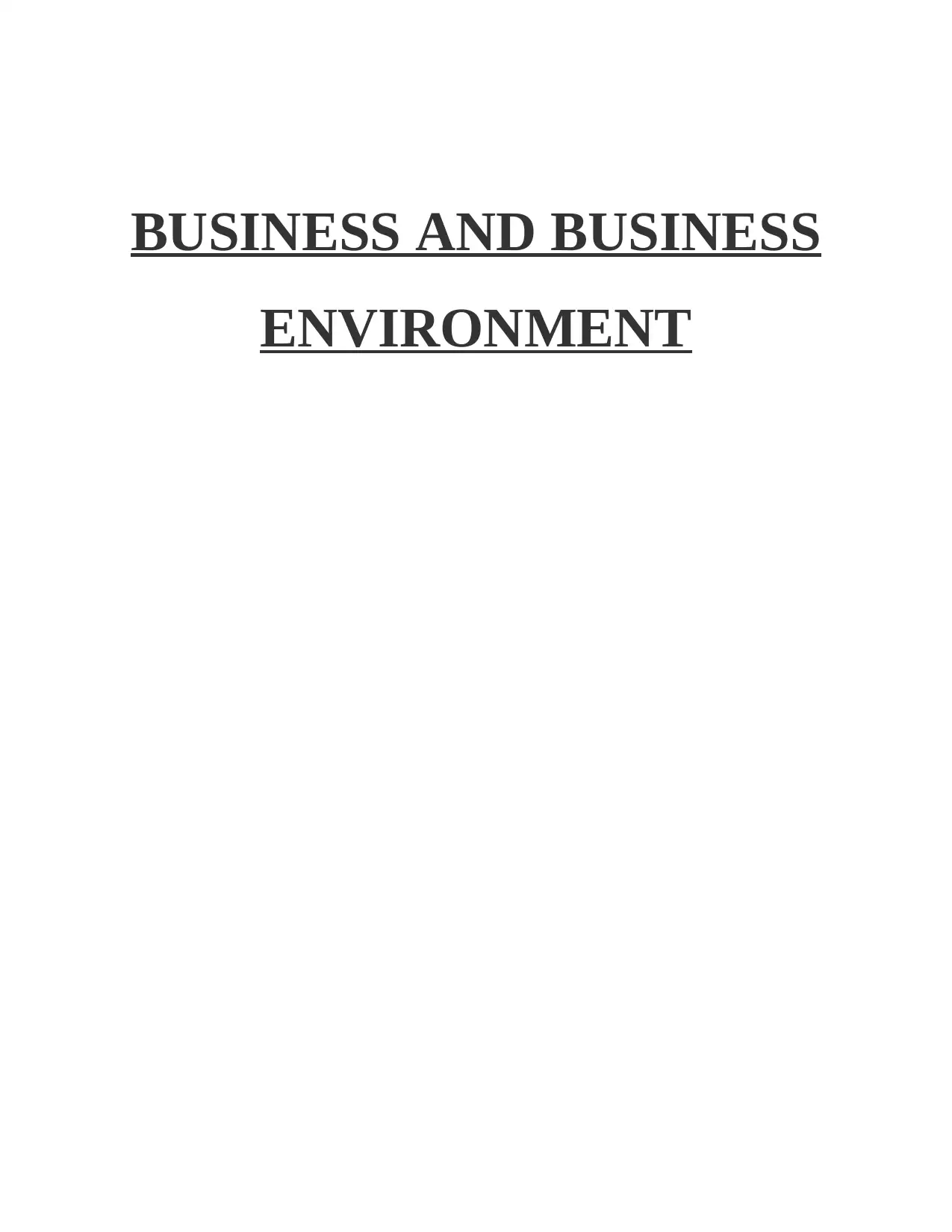
BUSINESS AND BUSINESS
ENVIRONMENT
ENVIRONMENT
Secure Best Marks with AI Grader
Need help grading? Try our AI Grader for instant feedback on your assignments.
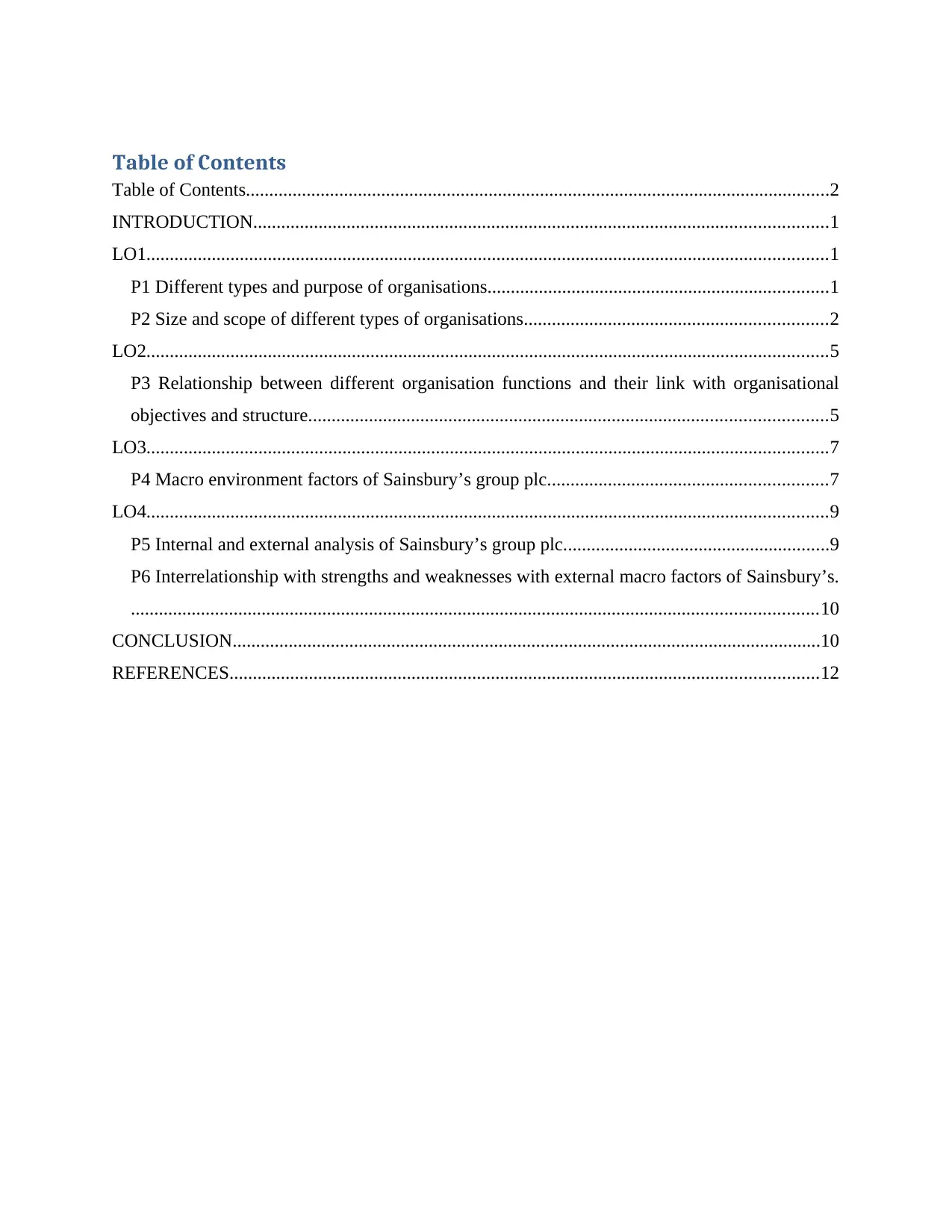
Table of Contents
Table of Contents.............................................................................................................................2
INTRODUCTION...........................................................................................................................1
LO1..................................................................................................................................................1
P1 Different types and purpose of organisations.........................................................................1
P2 Size and scope of different types of organisations.................................................................2
LO2..................................................................................................................................................5
P3 Relationship between different organisation functions and their link with organisational
objectives and structure...............................................................................................................5
LO3..................................................................................................................................................7
P4 Macro environment factors of Sainsbury’s group plc............................................................7
LO4..................................................................................................................................................9
P5 Internal and external analysis of Sainsbury’s group plc.........................................................9
P6 Interrelationship with strengths and weaknesses with external macro factors of Sainsbury’s.
...................................................................................................................................................10
CONCLUSION..............................................................................................................................10
REFERENCES..............................................................................................................................12
Table of Contents.............................................................................................................................2
INTRODUCTION...........................................................................................................................1
LO1..................................................................................................................................................1
P1 Different types and purpose of organisations.........................................................................1
P2 Size and scope of different types of organisations.................................................................2
LO2..................................................................................................................................................5
P3 Relationship between different organisation functions and their link with organisational
objectives and structure...............................................................................................................5
LO3..................................................................................................................................................7
P4 Macro environment factors of Sainsbury’s group plc............................................................7
LO4..................................................................................................................................................9
P5 Internal and external analysis of Sainsbury’s group plc.........................................................9
P6 Interrelationship with strengths and weaknesses with external macro factors of Sainsbury’s.
...................................................................................................................................................10
CONCLUSION..............................................................................................................................10
REFERENCES..............................................................................................................................12
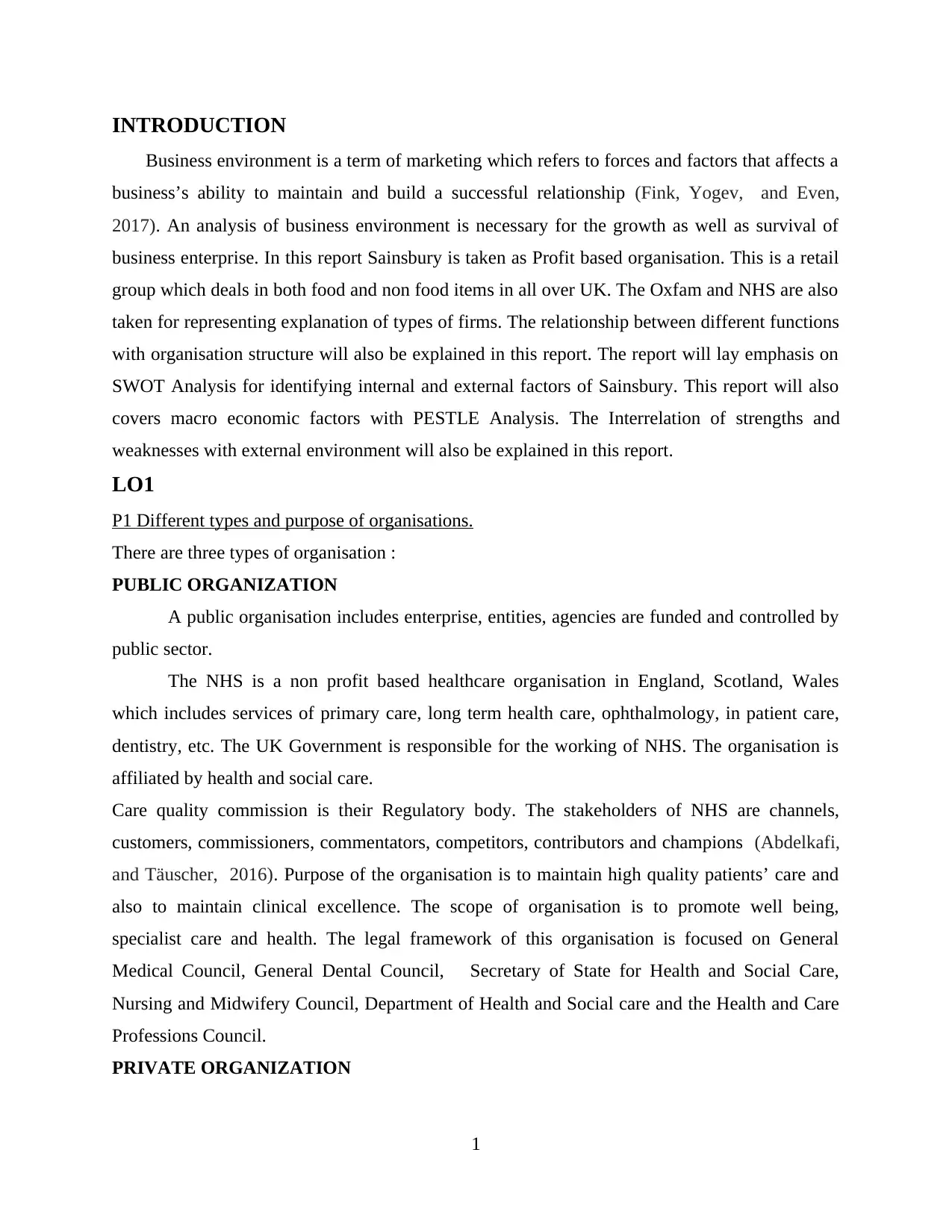
INTRODUCTION
Business environment is a term of marketing which refers to forces and factors that affects a
business’s ability to maintain and build a successful relationship (Fink, Yogev, and Even,
2017). An analysis of business environment is necessary for the growth as well as survival of
business enterprise. In this report Sainsbury is taken as Profit based organisation. This is a retail
group which deals in both food and non food items in all over UK. The Oxfam and NHS are also
taken for representing explanation of types of firms. The relationship between different functions
with organisation structure will also be explained in this report. The report will lay emphasis on
SWOT Analysis for identifying internal and external factors of Sainsbury. This report will also
covers macro economic factors with PESTLE Analysis. The Interrelation of strengths and
weaknesses with external environment will also be explained in this report.
LO1
P1 Different types and purpose of organisations.
There are three types of organisation :
PUBLIC ORGANIZATION
A public organisation includes enterprise, entities, agencies are funded and controlled by
public sector.
The NHS is a non profit based healthcare organisation in England, Scotland, Wales
which includes services of primary care, long term health care, ophthalmology, in patient care,
dentistry, etc. The UK Government is responsible for the working of NHS. The organisation is
affiliated by health and social care.
Care quality commission is their Regulatory body. The stakeholders of NHS are channels,
customers, commissioners, commentators, competitors, contributors and champions (Abdelkafi,
and Täuscher, 2016). Purpose of the organisation is to maintain high quality patients’ care and
also to maintain clinical excellence. The scope of organisation is to promote well being,
specialist care and health. The legal framework of this organisation is focused on General
Medical Council, General Dental Council, Secretary of State for Health and Social Care,
Nursing and Midwifery Council, Department of Health and Social care and the Health and Care
Professions Council.
PRIVATE ORGANIZATION
1
Business environment is a term of marketing which refers to forces and factors that affects a
business’s ability to maintain and build a successful relationship (Fink, Yogev, and Even,
2017). An analysis of business environment is necessary for the growth as well as survival of
business enterprise. In this report Sainsbury is taken as Profit based organisation. This is a retail
group which deals in both food and non food items in all over UK. The Oxfam and NHS are also
taken for representing explanation of types of firms. The relationship between different functions
with organisation structure will also be explained in this report. The report will lay emphasis on
SWOT Analysis for identifying internal and external factors of Sainsbury. This report will also
covers macro economic factors with PESTLE Analysis. The Interrelation of strengths and
weaknesses with external environment will also be explained in this report.
LO1
P1 Different types and purpose of organisations.
There are three types of organisation :
PUBLIC ORGANIZATION
A public organisation includes enterprise, entities, agencies are funded and controlled by
public sector.
The NHS is a non profit based healthcare organisation in England, Scotland, Wales
which includes services of primary care, long term health care, ophthalmology, in patient care,
dentistry, etc. The UK Government is responsible for the working of NHS. The organisation is
affiliated by health and social care.
Care quality commission is their Regulatory body. The stakeholders of NHS are channels,
customers, commissioners, commentators, competitors, contributors and champions (Abdelkafi,
and Täuscher, 2016). Purpose of the organisation is to maintain high quality patients’ care and
also to maintain clinical excellence. The scope of organisation is to promote well being,
specialist care and health. The legal framework of this organisation is focused on General
Medical Council, General Dental Council, Secretary of State for Health and Social Care,
Nursing and Midwifery Council, Department of Health and Social care and the Health and Care
Professions Council.
PRIVATE ORGANIZATION
1
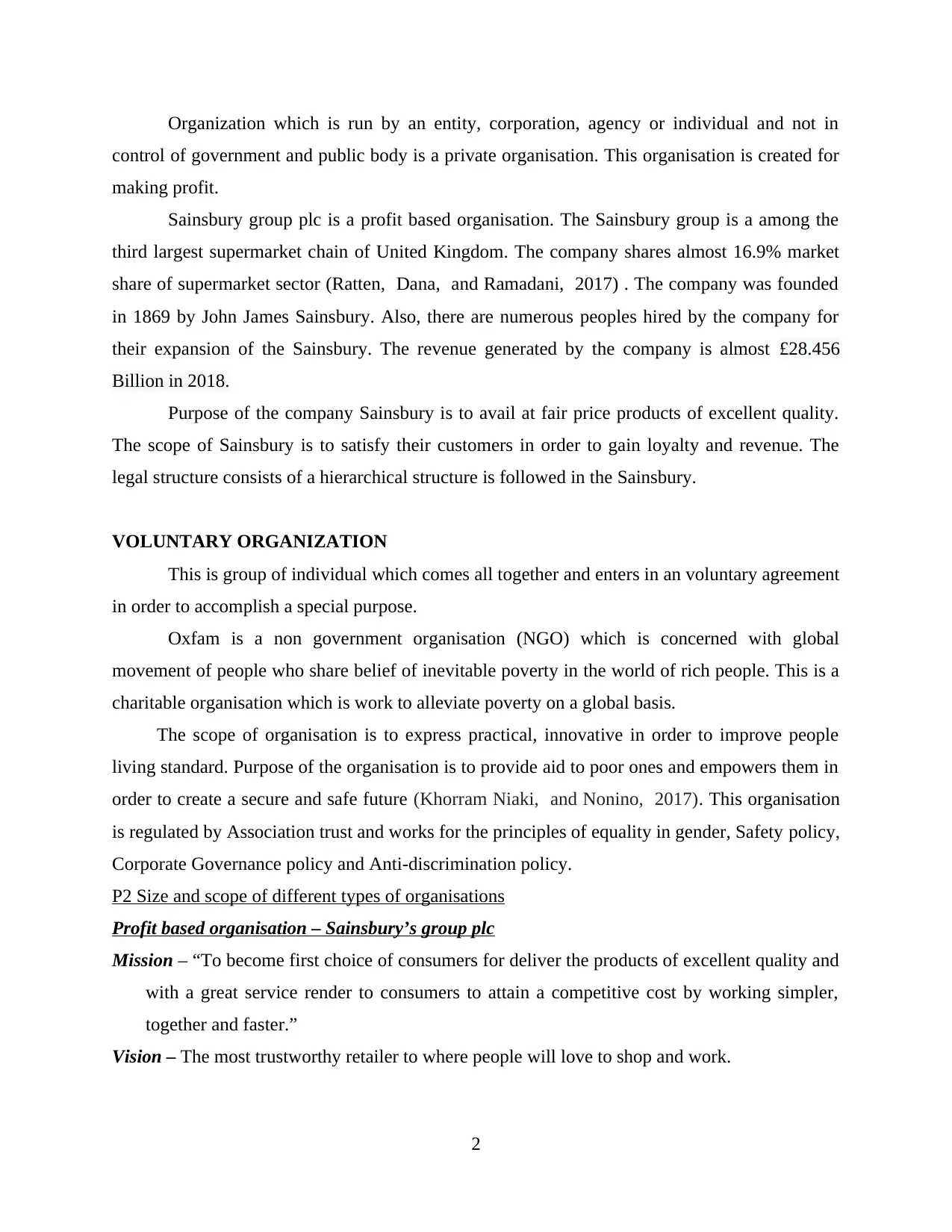
Organization which is run by an entity, corporation, agency or individual and not in
control of government and public body is a private organisation. This organisation is created for
making profit.
Sainsbury group plc is a profit based organisation. The Sainsbury group is a among the
third largest supermarket chain of United Kingdom. The company shares almost 16.9% market
share of supermarket sector (Ratten, Dana, and Ramadani, 2017) . The company was founded
in 1869 by John James Sainsbury. Also, there are numerous peoples hired by the company for
their expansion of the Sainsbury. The revenue generated by the company is almost £28.456
Billion in 2018.
Purpose of the company Sainsbury is to avail at fair price products of excellent quality.
The scope of Sainsbury is to satisfy their customers in order to gain loyalty and revenue. The
legal structure consists of a hierarchical structure is followed in the Sainsbury.
VOLUNTARY ORGANIZATION
This is group of individual which comes all together and enters in an voluntary agreement
in order to accomplish a special purpose.
Oxfam is a non government organisation (NGO) which is concerned with global
movement of people who share belief of inevitable poverty in the world of rich people. This is a
charitable organisation which is work to alleviate poverty on a global basis.
The scope of organisation is to express practical, innovative in order to improve people
living standard. Purpose of the organisation is to provide aid to poor ones and empowers them in
order to create a secure and safe future (Khorram Niaki, and Nonino, 2017). This organisation
is regulated by Association trust and works for the principles of equality in gender, Safety policy,
Corporate Governance policy and Anti-discrimination policy.
P2 Size and scope of different types of organisations
Profit based organisation – Sainsbury’s group plc
Mission – “To become first choice of consumers for deliver the products of excellent quality and
with a great service render to consumers to attain a competitive cost by working simpler,
together and faster.”
Vision – The most trustworthy retailer to where people will love to shop and work.
2
control of government and public body is a private organisation. This organisation is created for
making profit.
Sainsbury group plc is a profit based organisation. The Sainsbury group is a among the
third largest supermarket chain of United Kingdom. The company shares almost 16.9% market
share of supermarket sector (Ratten, Dana, and Ramadani, 2017) . The company was founded
in 1869 by John James Sainsbury. Also, there are numerous peoples hired by the company for
their expansion of the Sainsbury. The revenue generated by the company is almost £28.456
Billion in 2018.
Purpose of the company Sainsbury is to avail at fair price products of excellent quality.
The scope of Sainsbury is to satisfy their customers in order to gain loyalty and revenue. The
legal structure consists of a hierarchical structure is followed in the Sainsbury.
VOLUNTARY ORGANIZATION
This is group of individual which comes all together and enters in an voluntary agreement
in order to accomplish a special purpose.
Oxfam is a non government organisation (NGO) which is concerned with global
movement of people who share belief of inevitable poverty in the world of rich people. This is a
charitable organisation which is work to alleviate poverty on a global basis.
The scope of organisation is to express practical, innovative in order to improve people
living standard. Purpose of the organisation is to provide aid to poor ones and empowers them in
order to create a secure and safe future (Khorram Niaki, and Nonino, 2017). This organisation
is regulated by Association trust and works for the principles of equality in gender, Safety policy,
Corporate Governance policy and Anti-discrimination policy.
P2 Size and scope of different types of organisations
Profit based organisation – Sainsbury’s group plc
Mission – “To become first choice of consumers for deliver the products of excellent quality and
with a great service render to consumers to attain a competitive cost by working simpler,
together and faster.”
Vision – The most trustworthy retailer to where people will love to shop and work.
2
Secure Best Marks with AI Grader
Need help grading? Try our AI Grader for instant feedback on your assignments.
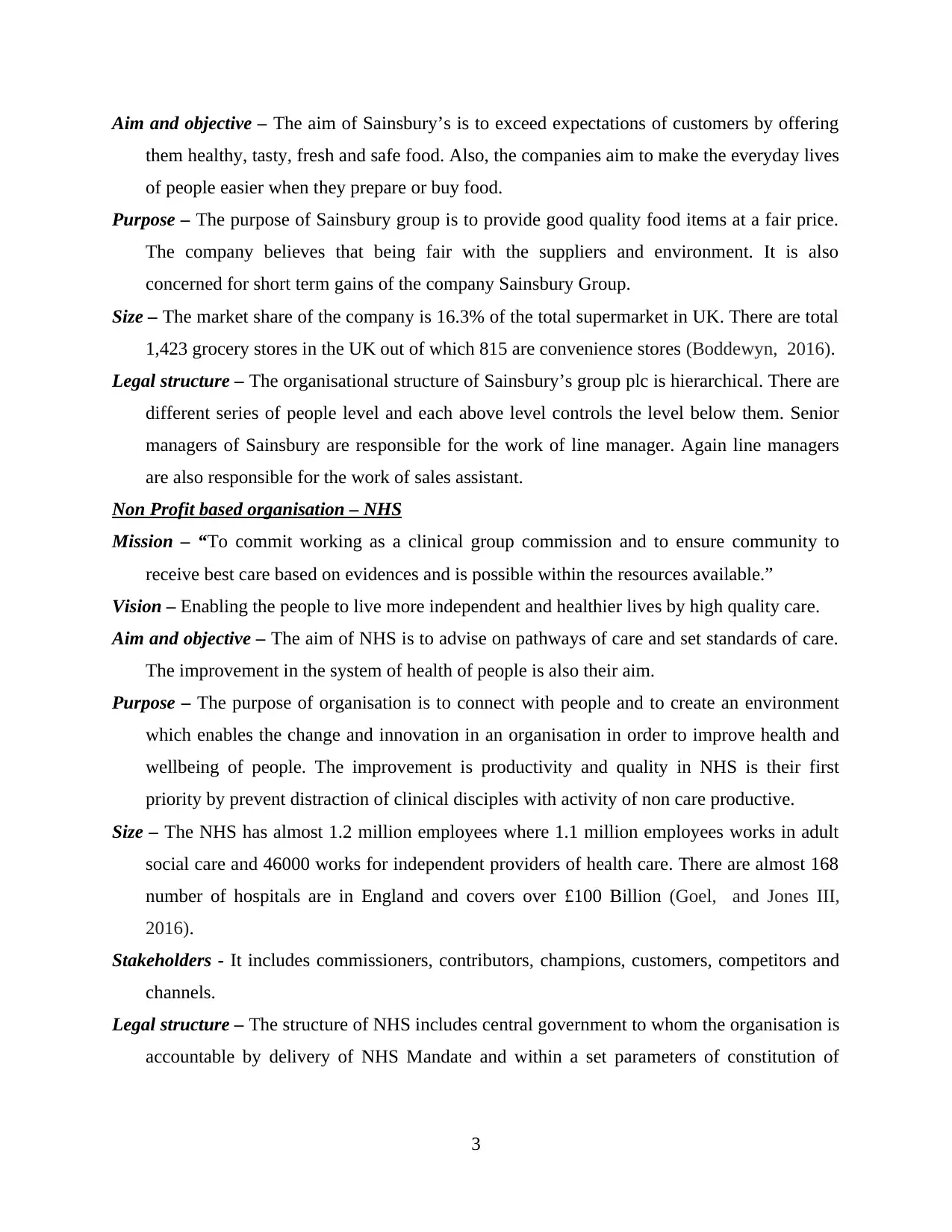
Aim and objective – The aim of Sainsbury’s is to exceed expectations of customers by offering
them healthy, tasty, fresh and safe food. Also, the companies aim to make the everyday lives
of people easier when they prepare or buy food.
Purpose – The purpose of Sainsbury group is to provide good quality food items at a fair price.
The company believes that being fair with the suppliers and environment. It is also
concerned for short term gains of the company Sainsbury Group.
Size – The market share of the company is 16.3% of the total supermarket in UK. There are total
1,423 grocery stores in the UK out of which 815 are convenience stores (Boddewyn, 2016).
Legal structure – The organisational structure of Sainsbury’s group plc is hierarchical. There are
different series of people level and each above level controls the level below them. Senior
managers of Sainsbury are responsible for the work of line manager. Again line managers
are also responsible for the work of sales assistant.
Non Profit based organisation – NHS
Mission – “To commit working as a clinical group commission and to ensure community to
receive best care based on evidences and is possible within the resources available.”
Vision – Enabling the people to live more independent and healthier lives by high quality care.
Aim and objective – The aim of NHS is to advise on pathways of care and set standards of care.
The improvement in the system of health of people is also their aim.
Purpose – The purpose of organisation is to connect with people and to create an environment
which enables the change and innovation in an organisation in order to improve health and
wellbeing of people. The improvement is productivity and quality in NHS is their first
priority by prevent distraction of clinical disciples with activity of non care productive.
Size – The NHS has almost 1.2 million employees where 1.1 million employees works in adult
social care and 46000 works for independent providers of health care. There are almost 168
number of hospitals are in England and covers over £100 Billion (Goel, and Jones III,
2016).
Stakeholders - It includes commissioners, contributors, champions, customers, competitors and
channels.
Legal structure – The structure of NHS includes central government to whom the organisation is
accountable by delivery of NHS Mandate and within a set parameters of constitution of
3
them healthy, tasty, fresh and safe food. Also, the companies aim to make the everyday lives
of people easier when they prepare or buy food.
Purpose – The purpose of Sainsbury group is to provide good quality food items at a fair price.
The company believes that being fair with the suppliers and environment. It is also
concerned for short term gains of the company Sainsbury Group.
Size – The market share of the company is 16.3% of the total supermarket in UK. There are total
1,423 grocery stores in the UK out of which 815 are convenience stores (Boddewyn, 2016).
Legal structure – The organisational structure of Sainsbury’s group plc is hierarchical. There are
different series of people level and each above level controls the level below them. Senior
managers of Sainsbury are responsible for the work of line manager. Again line managers
are also responsible for the work of sales assistant.
Non Profit based organisation – NHS
Mission – “To commit working as a clinical group commission and to ensure community to
receive best care based on evidences and is possible within the resources available.”
Vision – Enabling the people to live more independent and healthier lives by high quality care.
Aim and objective – The aim of NHS is to advise on pathways of care and set standards of care.
The improvement in the system of health of people is also their aim.
Purpose – The purpose of organisation is to connect with people and to create an environment
which enables the change and innovation in an organisation in order to improve health and
wellbeing of people. The improvement is productivity and quality in NHS is their first
priority by prevent distraction of clinical disciples with activity of non care productive.
Size – The NHS has almost 1.2 million employees where 1.1 million employees works in adult
social care and 46000 works for independent providers of health care. There are almost 168
number of hospitals are in England and covers over £100 Billion (Goel, and Jones III,
2016).
Stakeholders - It includes commissioners, contributors, champions, customers, competitors and
channels.
Legal structure – The structure of NHS includes central government to whom the organisation is
accountable by delivery of NHS Mandate and within a set parameters of constitution of
3

NHS. The structure of NHS includes Department for health, NHS England, Clinical
Commissioning Groups (CCGs) and NHS foundation trusts.
Figure 1 Organisational structure of NHS
(Source : Organisational structure, 2016)
Non government organisation – Oxfam
Mission – “To help in creation of solution for the poverty injustice. The Oxfam is the part of
moment of global which empowers people to create a secure future which is just free from
poverty.”
Vision – To make a world in which there is no existence of poverty. People are valued, equally
treated and also able to enjoy rights of citizen.
Aim and objective – The aim of Oxfam is to help people for claiming their rights to make a
better life. The main objective of Oxfam is to safeguard supplies of food globally in order to
provide full meal to poor. Also, the Oxfam aims to empower equal rights for women.
Purpose – The purpose of Oxfam is to help people which they suffer by injustice of poverty. The
organisation enables a global movement in which they are trying to influence people which
affect their lives and they are able to enjoy their rights.
Size – There are 52 charity shops operating Oxfam organisation which includes boutiques and
bookshops (Ward, 2016). There are also 2400 volunteers hired by Oxfam in their shops.
Oxfam have 5300 people working in their organisation worldwide.
Stakeholders – It includes agencies of government, donors, suppliers, managers, partners and
shareholders.
4
Commissioning Groups (CCGs) and NHS foundation trusts.
Figure 1 Organisational structure of NHS
(Source : Organisational structure, 2016)
Non government organisation – Oxfam
Mission – “To help in creation of solution for the poverty injustice. The Oxfam is the part of
moment of global which empowers people to create a secure future which is just free from
poverty.”
Vision – To make a world in which there is no existence of poverty. People are valued, equally
treated and also able to enjoy rights of citizen.
Aim and objective – The aim of Oxfam is to help people for claiming their rights to make a
better life. The main objective of Oxfam is to safeguard supplies of food globally in order to
provide full meal to poor. Also, the Oxfam aims to empower equal rights for women.
Purpose – The purpose of Oxfam is to help people which they suffer by injustice of poverty. The
organisation enables a global movement in which they are trying to influence people which
affect their lives and they are able to enjoy their rights.
Size – There are 52 charity shops operating Oxfam organisation which includes boutiques and
bookshops (Ward, 2016). There are also 2400 volunteers hired by Oxfam in their shops.
Oxfam have 5300 people working in their organisation worldwide.
Stakeholders – It includes agencies of government, donors, suppliers, managers, partners and
shareholders.
4

Legal structure – The Oxfam have a geographical structure as they work all over the world
along with numerous countries for helping the people in need. The organisation includes
council of CEO, Directors and trustee.
Types of enterprises according to size
Micro enterprises – A micro enterprise deals with very small businesses which employees
maximum 9 peoples. Also, they have turnover which is less than a fixed amount generally £
2 million (Petlina, 2015).
Small enterprise – This business is larger than micro enterprises and engages number of
employees which is less than 250.
Large enterprise - In this enterprise of business, number of employees are more than 250 and
their turnover is also more than micro and small enterprise.
LO2
P3 Relationship between different organisation functions and their link with organisational
objectives and structure.
Functions of Sainsbury group plc are :
Finance function – This function of Sainsbury is concerned with financial performance
of the company in order to ascertain the company in earning profit and bearing loss. It
also provides helps in taking financial decisions by executing comparison between actual
and predict performance.
Administration function – The Sainsbury lay focus to ensure manner for which
employees execute tasks for smooth operations and functioning. It also ensures
appropriate communication between manager as well as employees in order to achieve
effective goals (Kajalo, and Lindblom, 2015).
Sales function – This function helps Sainsbury in introducing new services and products
in market by ensuring and attracts customers regarding it. Research and development function – This function is helpful in providing latest
information of technology which can be used by company to maximize margin of profit
and also helps the company in gaining satisfaction of customers.
Organizational structure of Sainsbury
5
along with numerous countries for helping the people in need. The organisation includes
council of CEO, Directors and trustee.
Types of enterprises according to size
Micro enterprises – A micro enterprise deals with very small businesses which employees
maximum 9 peoples. Also, they have turnover which is less than a fixed amount generally £
2 million (Petlina, 2015).
Small enterprise – This business is larger than micro enterprises and engages number of
employees which is less than 250.
Large enterprise - In this enterprise of business, number of employees are more than 250 and
their turnover is also more than micro and small enterprise.
LO2
P3 Relationship between different organisation functions and their link with organisational
objectives and structure.
Functions of Sainsbury group plc are :
Finance function – This function of Sainsbury is concerned with financial performance
of the company in order to ascertain the company in earning profit and bearing loss. It
also provides helps in taking financial decisions by executing comparison between actual
and predict performance.
Administration function – The Sainsbury lay focus to ensure manner for which
employees execute tasks for smooth operations and functioning. It also ensures
appropriate communication between manager as well as employees in order to achieve
effective goals (Kajalo, and Lindblom, 2015).
Sales function – This function helps Sainsbury in introducing new services and products
in market by ensuring and attracts customers regarding it. Research and development function – This function is helpful in providing latest
information of technology which can be used by company to maximize margin of profit
and also helps the company in gaining satisfaction of customers.
Organizational structure of Sainsbury
5
Paraphrase This Document
Need a fresh take? Get an instant paraphrase of this document with our AI Paraphraser
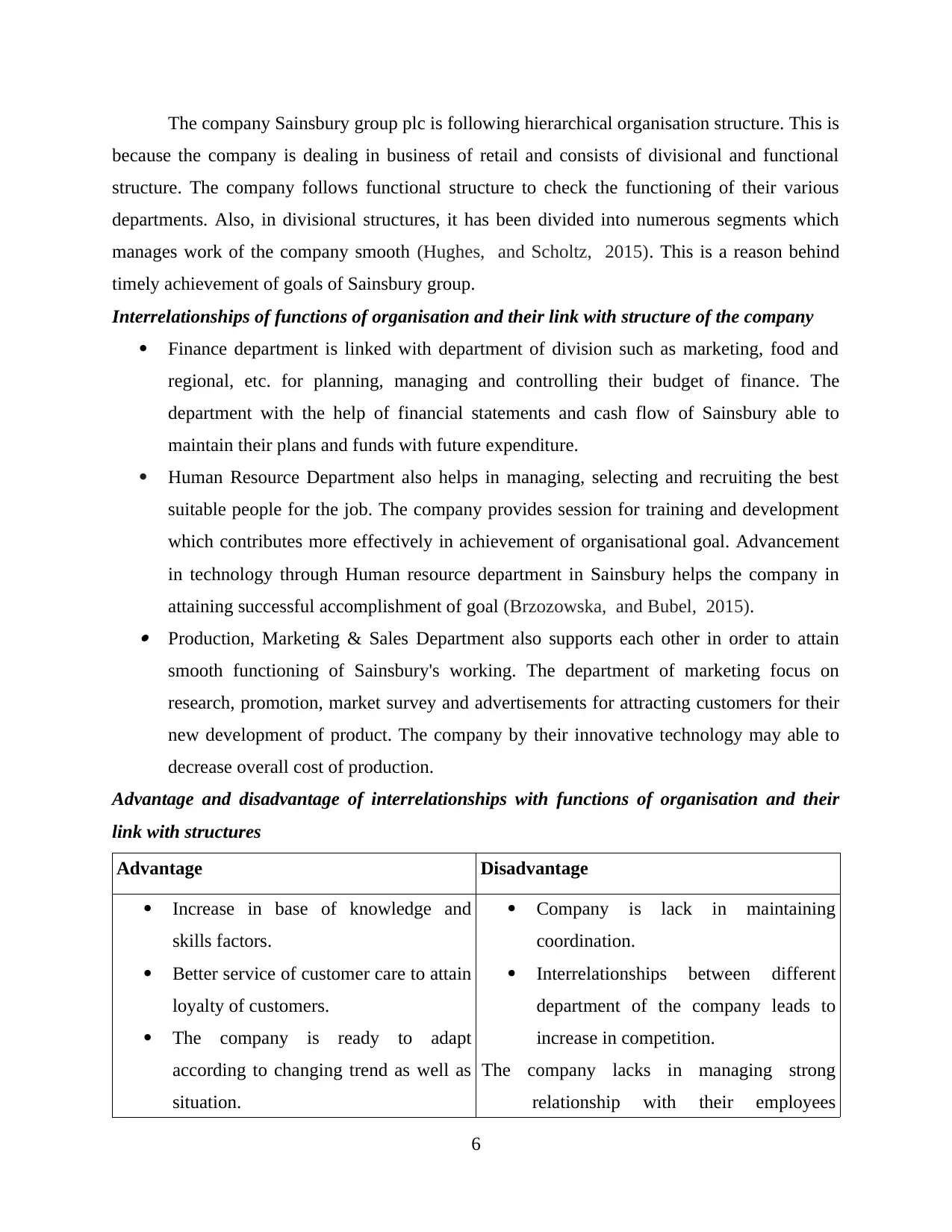
The company Sainsbury group plc is following hierarchical organisation structure. This is
because the company is dealing in business of retail and consists of divisional and functional
structure. The company follows functional structure to check the functioning of their various
departments. Also, in divisional structures, it has been divided into numerous segments which
manages work of the company smooth (Hughes, and Scholtz, 2015). This is a reason behind
timely achievement of goals of Sainsbury group.
Interrelationships of functions of organisation and their link with structure of the company
Finance department is linked with department of division such as marketing, food and
regional, etc. for planning, managing and controlling their budget of finance. The
department with the help of financial statements and cash flow of Sainsbury able to
maintain their plans and funds with future expenditure.
Human Resource Department also helps in managing, selecting and recruiting the best
suitable people for the job. The company provides session for training and development
which contributes more effectively in achievement of organisational goal. Advancement
in technology through Human resource department in Sainsbury helps the company in
attaining successful accomplishment of goal (Brzozowska, and Bubel, 2015). Production, Marketing & Sales Department also supports each other in order to attain
smooth functioning of Sainsbury's working. The department of marketing focus on
research, promotion, market survey and advertisements for attracting customers for their
new development of product. The company by their innovative technology may able to
decrease overall cost of production.
Advantage and disadvantage of interrelationships with functions of organisation and their
link with structures
Advantage Disadvantage
Increase in base of knowledge and
skills factors.
Better service of customer care to attain
loyalty of customers.
The company is ready to adapt
according to changing trend as well as
situation.
Company is lack in maintaining
coordination.
Interrelationships between different
department of the company leads to
increase in competition.
The company lacks in managing strong
relationship with their employees
6
because the company is dealing in business of retail and consists of divisional and functional
structure. The company follows functional structure to check the functioning of their various
departments. Also, in divisional structures, it has been divided into numerous segments which
manages work of the company smooth (Hughes, and Scholtz, 2015). This is a reason behind
timely achievement of goals of Sainsbury group.
Interrelationships of functions of organisation and their link with structure of the company
Finance department is linked with department of division such as marketing, food and
regional, etc. for planning, managing and controlling their budget of finance. The
department with the help of financial statements and cash flow of Sainsbury able to
maintain their plans and funds with future expenditure.
Human Resource Department also helps in managing, selecting and recruiting the best
suitable people for the job. The company provides session for training and development
which contributes more effectively in achievement of organisational goal. Advancement
in technology through Human resource department in Sainsbury helps the company in
attaining successful accomplishment of goal (Brzozowska, and Bubel, 2015). Production, Marketing & Sales Department also supports each other in order to attain
smooth functioning of Sainsbury's working. The department of marketing focus on
research, promotion, market survey and advertisements for attracting customers for their
new development of product. The company by their innovative technology may able to
decrease overall cost of production.
Advantage and disadvantage of interrelationships with functions of organisation and their
link with structures
Advantage Disadvantage
Increase in base of knowledge and
skills factors.
Better service of customer care to attain
loyalty of customers.
The company is ready to adapt
according to changing trend as well as
situation.
Company is lack in maintaining
coordination.
Interrelationships between different
department of the company leads to
increase in competition.
The company lacks in managing strong
relationship with their employees
6
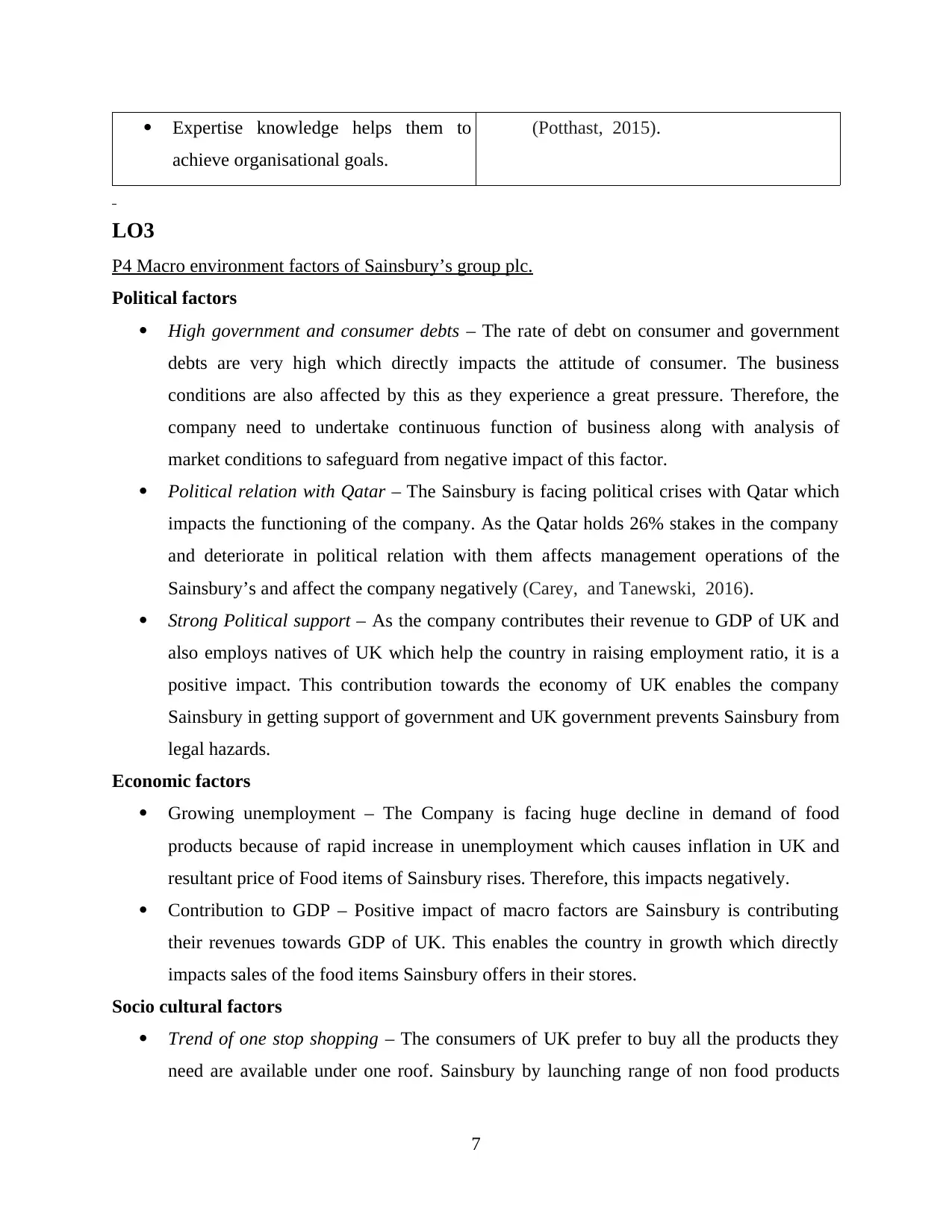
Expertise knowledge helps them to
achieve organisational goals.
(Potthast, 2015).
LO3
P4 Macro environment factors of Sainsbury’s group plc.
Political factors
High government and consumer debts – The rate of debt on consumer and government
debts are very high which directly impacts the attitude of consumer. The business
conditions are also affected by this as they experience a great pressure. Therefore, the
company need to undertake continuous function of business along with analysis of
market conditions to safeguard from negative impact of this factor.
Political relation with Qatar – The Sainsbury is facing political crises with Qatar which
impacts the functioning of the company. As the Qatar holds 26% stakes in the company
and deteriorate in political relation with them affects management operations of the
Sainsbury’s and affect the company negatively (Carey, and Tanewski, 2016).
Strong Political support – As the company contributes their revenue to GDP of UK and
also employs natives of UK which help the country in raising employment ratio, it is a
positive impact. This contribution towards the economy of UK enables the company
Sainsbury in getting support of government and UK government prevents Sainsbury from
legal hazards.
Economic factors
Growing unemployment – The Company is facing huge decline in demand of food
products because of rapid increase in unemployment which causes inflation in UK and
resultant price of Food items of Sainsbury rises. Therefore, this impacts negatively.
Contribution to GDP – Positive impact of macro factors are Sainsbury is contributing
their revenues towards GDP of UK. This enables the country in growth which directly
impacts sales of the food items Sainsbury offers in their stores.
Socio cultural factors
Trend of one stop shopping – The consumers of UK prefer to buy all the products they
need are available under one roof. Sainsbury by launching range of non food products
7
achieve organisational goals.
(Potthast, 2015).
LO3
P4 Macro environment factors of Sainsbury’s group plc.
Political factors
High government and consumer debts – The rate of debt on consumer and government
debts are very high which directly impacts the attitude of consumer. The business
conditions are also affected by this as they experience a great pressure. Therefore, the
company need to undertake continuous function of business along with analysis of
market conditions to safeguard from negative impact of this factor.
Political relation with Qatar – The Sainsbury is facing political crises with Qatar which
impacts the functioning of the company. As the Qatar holds 26% stakes in the company
and deteriorate in political relation with them affects management operations of the
Sainsbury’s and affect the company negatively (Carey, and Tanewski, 2016).
Strong Political support – As the company contributes their revenue to GDP of UK and
also employs natives of UK which help the country in raising employment ratio, it is a
positive impact. This contribution towards the economy of UK enables the company
Sainsbury in getting support of government and UK government prevents Sainsbury from
legal hazards.
Economic factors
Growing unemployment – The Company is facing huge decline in demand of food
products because of rapid increase in unemployment which causes inflation in UK and
resultant price of Food items of Sainsbury rises. Therefore, this impacts negatively.
Contribution to GDP – Positive impact of macro factors are Sainsbury is contributing
their revenues towards GDP of UK. This enables the country in growth which directly
impacts sales of the food items Sainsbury offers in their stores.
Socio cultural factors
Trend of one stop shopping – The consumers of UK prefer to buy all the products they
need are available under one roof. Sainsbury by launching range of non food products
7

avail benefit by growing trend of one stop shopping. This way socio cultural factors
impacts positively on company.
Demand of organic food in trend – The Sainsbury is earning a lot of profit by introducing
range of organic food in UK. The sale therefore increases by 20% by availability organic
foods in their brand.
Technological factors
Use of online sites for delivering food – The consumers order their food online through
official site of Sainsbury and the company delivers their ordered food at their
convenience. The use of online technology implies 25% increase in sales and 88% of the
consumers use these online services all over UK.
Cash less payment – Sainsbury enables their consumers to use digital method of
payments through cards, and apps. This saves time of both consumer as well as billing
personnel of Sainsbury stores.
Legal factors
Regulatory approvals – Sainsbury is always delaying in decision making and this impacts
their growth in industry of retail. The regulatory approvals convey a negative impact on
business and it takes time for final approval. Therefore the company is losing prevailing
opportunities in the market.
Employment law – The Sainsbury is following employment law under which they
provide proper health and safety assurance, medical facility, leaves allowance and
benefits like perks and bonuses to their employees as stated in employment law.
Therefore, by following this law the company employees’ retention ratio is better than
any other retail stores and also they are free from any legal hazards. Thus, this factors
impacts positively to Salisbury’s performance.
Environmental factors
Approach of Reduce, Recycle and Reuse – The Company took an initiative in order to
safeguard environment (Graça, and Camarinha-Matos, 2017. The company manages
waste, packaging and recycle it. The company is also working on carbon footprints in
order to reduce pollution. Therefore, the image of Sainsbury improves with this initiative
and impacts positively on the company.
8
impacts positively on company.
Demand of organic food in trend – The Sainsbury is earning a lot of profit by introducing
range of organic food in UK. The sale therefore increases by 20% by availability organic
foods in their brand.
Technological factors
Use of online sites for delivering food – The consumers order their food online through
official site of Sainsbury and the company delivers their ordered food at their
convenience. The use of online technology implies 25% increase in sales and 88% of the
consumers use these online services all over UK.
Cash less payment – Sainsbury enables their consumers to use digital method of
payments through cards, and apps. This saves time of both consumer as well as billing
personnel of Sainsbury stores.
Legal factors
Regulatory approvals – Sainsbury is always delaying in decision making and this impacts
their growth in industry of retail. The regulatory approvals convey a negative impact on
business and it takes time for final approval. Therefore the company is losing prevailing
opportunities in the market.
Employment law – The Sainsbury is following employment law under which they
provide proper health and safety assurance, medical facility, leaves allowance and
benefits like perks and bonuses to their employees as stated in employment law.
Therefore, by following this law the company employees’ retention ratio is better than
any other retail stores and also they are free from any legal hazards. Thus, this factors
impacts positively to Salisbury’s performance.
Environmental factors
Approach of Reduce, Recycle and Reuse – The Company took an initiative in order to
safeguard environment (Graça, and Camarinha-Matos, 2017. The company manages
waste, packaging and recycle it. The company is also working on carbon footprints in
order to reduce pollution. Therefore, the image of Sainsbury improves with this initiative
and impacts positively on the company.
8
Secure Best Marks with AI Grader
Need help grading? Try our AI Grader for instant feedback on your assignments.
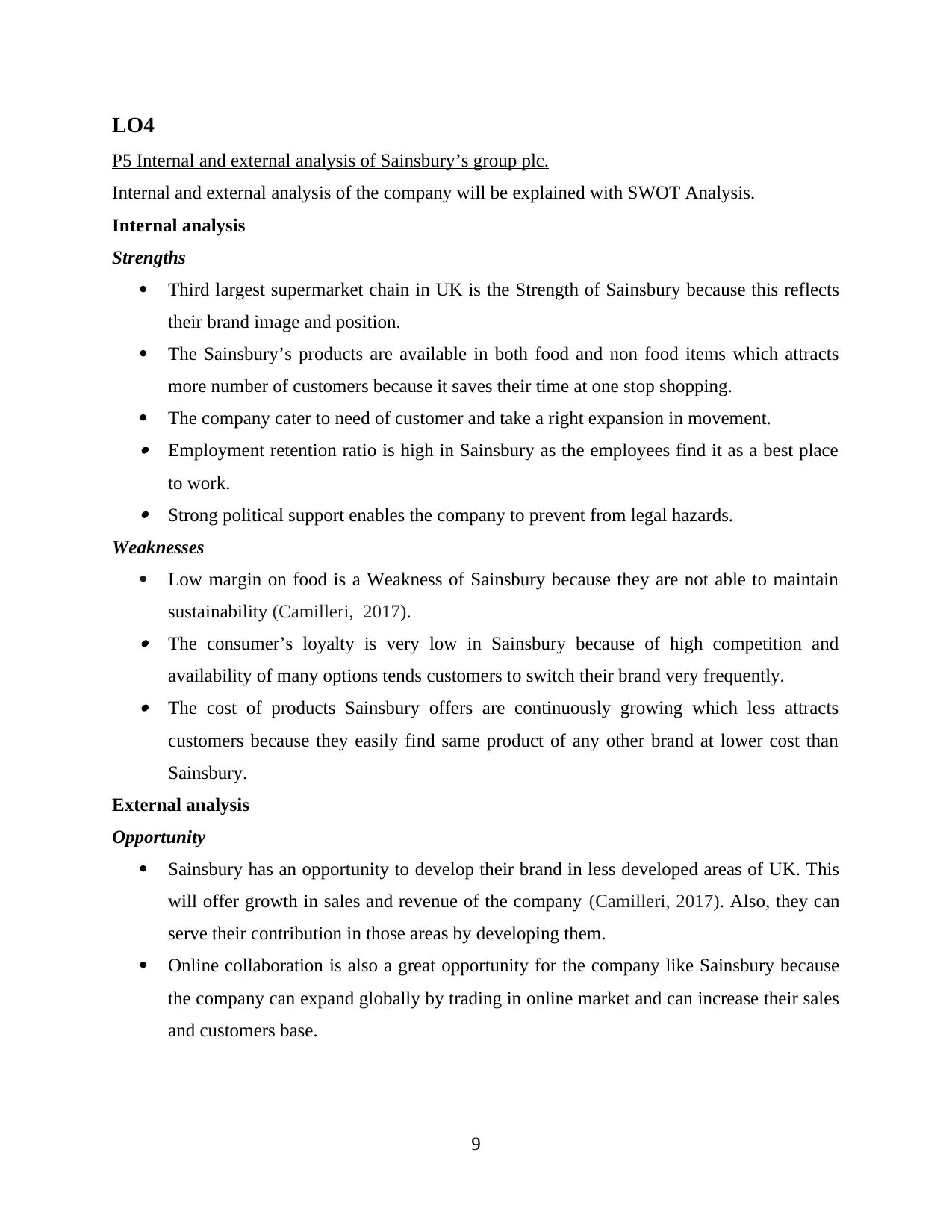
LO4
P5 Internal and external analysis of Sainsbury’s group plc.
Internal and external analysis of the company will be explained with SWOT Analysis.
Internal analysis
Strengths
Third largest supermarket chain in UK is the Strength of Sainsbury because this reflects
their brand image and position.
The Sainsbury’s products are available in both food and non food items which attracts
more number of customers because it saves their time at one stop shopping.
The company cater to need of customer and take a right expansion in movement. Employment retention ratio is high in Sainsbury as the employees find it as a best place
to work. Strong political support enables the company to prevent from legal hazards.
Weaknesses
Low margin on food is a Weakness of Sainsbury because they are not able to maintain
sustainability (Camilleri, 2017). The consumer’s loyalty is very low in Sainsbury because of high competition and
availability of many options tends customers to switch their brand very frequently. The cost of products Sainsbury offers are continuously growing which less attracts
customers because they easily find same product of any other brand at lower cost than
Sainsbury.
External analysis
Opportunity
Sainsbury has an opportunity to develop their brand in less developed areas of UK. This
will offer growth in sales and revenue of the company (Camilleri, 2017). Also, they can
serve their contribution in those areas by developing them.
Online collaboration is also a great opportunity for the company like Sainsbury because
the company can expand globally by trading in online market and can increase their sales
and customers base.
9
P5 Internal and external analysis of Sainsbury’s group plc.
Internal and external analysis of the company will be explained with SWOT Analysis.
Internal analysis
Strengths
Third largest supermarket chain in UK is the Strength of Sainsbury because this reflects
their brand image and position.
The Sainsbury’s products are available in both food and non food items which attracts
more number of customers because it saves their time at one stop shopping.
The company cater to need of customer and take a right expansion in movement. Employment retention ratio is high in Sainsbury as the employees find it as a best place
to work. Strong political support enables the company to prevent from legal hazards.
Weaknesses
Low margin on food is a Weakness of Sainsbury because they are not able to maintain
sustainability (Camilleri, 2017). The consumer’s loyalty is very low in Sainsbury because of high competition and
availability of many options tends customers to switch their brand very frequently. The cost of products Sainsbury offers are continuously growing which less attracts
customers because they easily find same product of any other brand at lower cost than
Sainsbury.
External analysis
Opportunity
Sainsbury has an opportunity to develop their brand in less developed areas of UK. This
will offer growth in sales and revenue of the company (Camilleri, 2017). Also, they can
serve their contribution in those areas by developing them.
Online collaboration is also a great opportunity for the company like Sainsbury because
the company can expand globally by trading in online market and can increase their sales
and customers base.
9
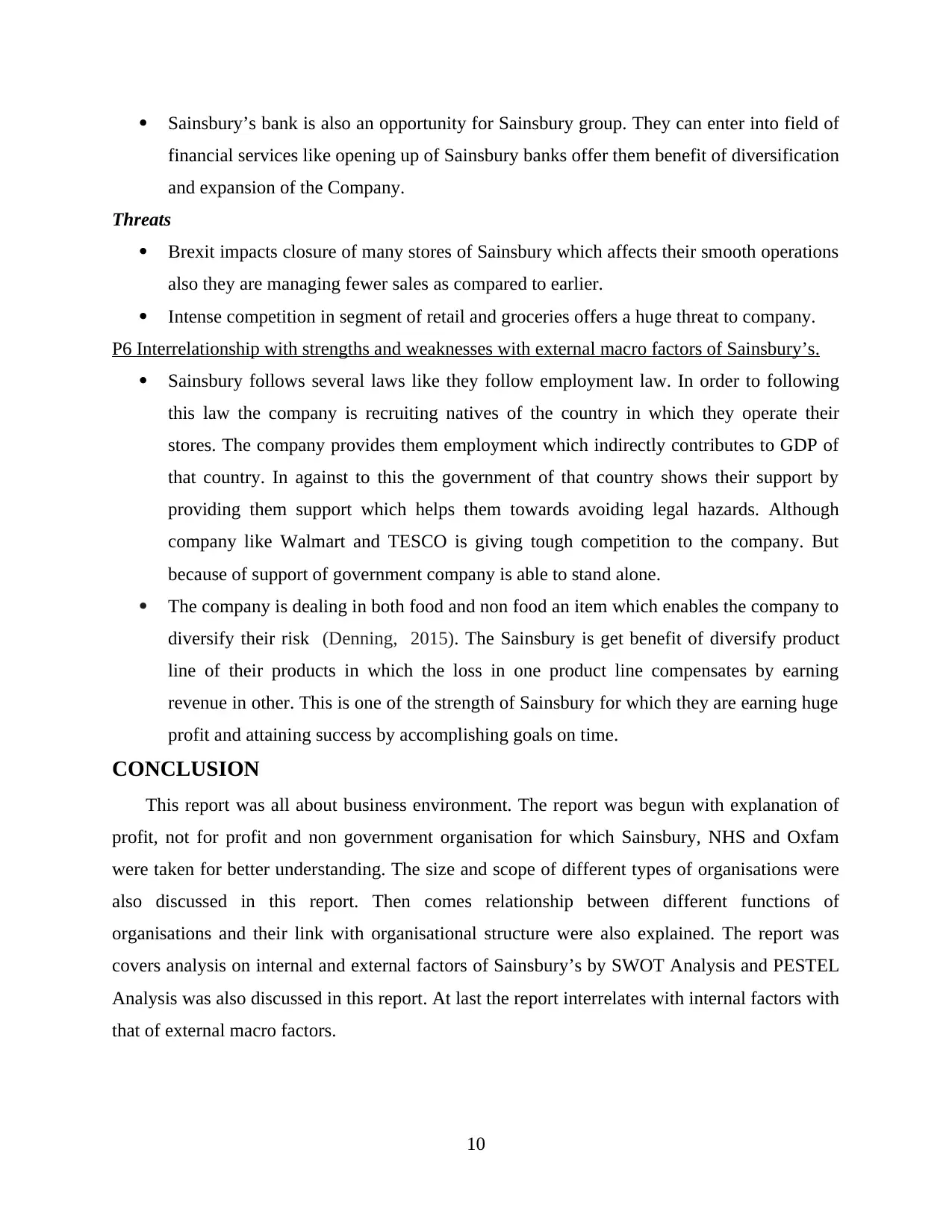
Sainsbury’s bank is also an opportunity for Sainsbury group. They can enter into field of
financial services like opening up of Sainsbury banks offer them benefit of diversification
and expansion of the Company.
Threats
Brexit impacts closure of many stores of Sainsbury which affects their smooth operations
also they are managing fewer sales as compared to earlier.
Intense competition in segment of retail and groceries offers a huge threat to company.
P6 Interrelationship with strengths and weaknesses with external macro factors of Sainsbury’s.
Sainsbury follows several laws like they follow employment law. In order to following
this law the company is recruiting natives of the country in which they operate their
stores. The company provides them employment which indirectly contributes to GDP of
that country. In against to this the government of that country shows their support by
providing them support which helps them towards avoiding legal hazards. Although
company like Walmart and TESCO is giving tough competition to the company. But
because of support of government company is able to stand alone.
The company is dealing in both food and non food an item which enables the company to
diversify their risk (Denning, 2015). The Sainsbury is get benefit of diversify product
line of their products in which the loss in one product line compensates by earning
revenue in other. This is one of the strength of Sainsbury for which they are earning huge
profit and attaining success by accomplishing goals on time.
CONCLUSION
This report was all about business environment. The report was begun with explanation of
profit, not for profit and non government organisation for which Sainsbury, NHS and Oxfam
were taken for better understanding. The size and scope of different types of organisations were
also discussed in this report. Then comes relationship between different functions of
organisations and their link with organisational structure were also explained. The report was
covers analysis on internal and external factors of Sainsbury’s by SWOT Analysis and PESTEL
Analysis was also discussed in this report. At last the report interrelates with internal factors with
that of external macro factors.
10
financial services like opening up of Sainsbury banks offer them benefit of diversification
and expansion of the Company.
Threats
Brexit impacts closure of many stores of Sainsbury which affects their smooth operations
also they are managing fewer sales as compared to earlier.
Intense competition in segment of retail and groceries offers a huge threat to company.
P6 Interrelationship with strengths and weaknesses with external macro factors of Sainsbury’s.
Sainsbury follows several laws like they follow employment law. In order to following
this law the company is recruiting natives of the country in which they operate their
stores. The company provides them employment which indirectly contributes to GDP of
that country. In against to this the government of that country shows their support by
providing them support which helps them towards avoiding legal hazards. Although
company like Walmart and TESCO is giving tough competition to the company. But
because of support of government company is able to stand alone.
The company is dealing in both food and non food an item which enables the company to
diversify their risk (Denning, 2015). The Sainsbury is get benefit of diversify product
line of their products in which the loss in one product line compensates by earning
revenue in other. This is one of the strength of Sainsbury for which they are earning huge
profit and attaining success by accomplishing goals on time.
CONCLUSION
This report was all about business environment. The report was begun with explanation of
profit, not for profit and non government organisation for which Sainsbury, NHS and Oxfam
were taken for better understanding. The size and scope of different types of organisations were
also discussed in this report. Then comes relationship between different functions of
organisations and their link with organisational structure were also explained. The report was
covers analysis on internal and external factors of Sainsbury’s by SWOT Analysis and PESTEL
Analysis was also discussed in this report. At last the report interrelates with internal factors with
that of external macro factors.
10
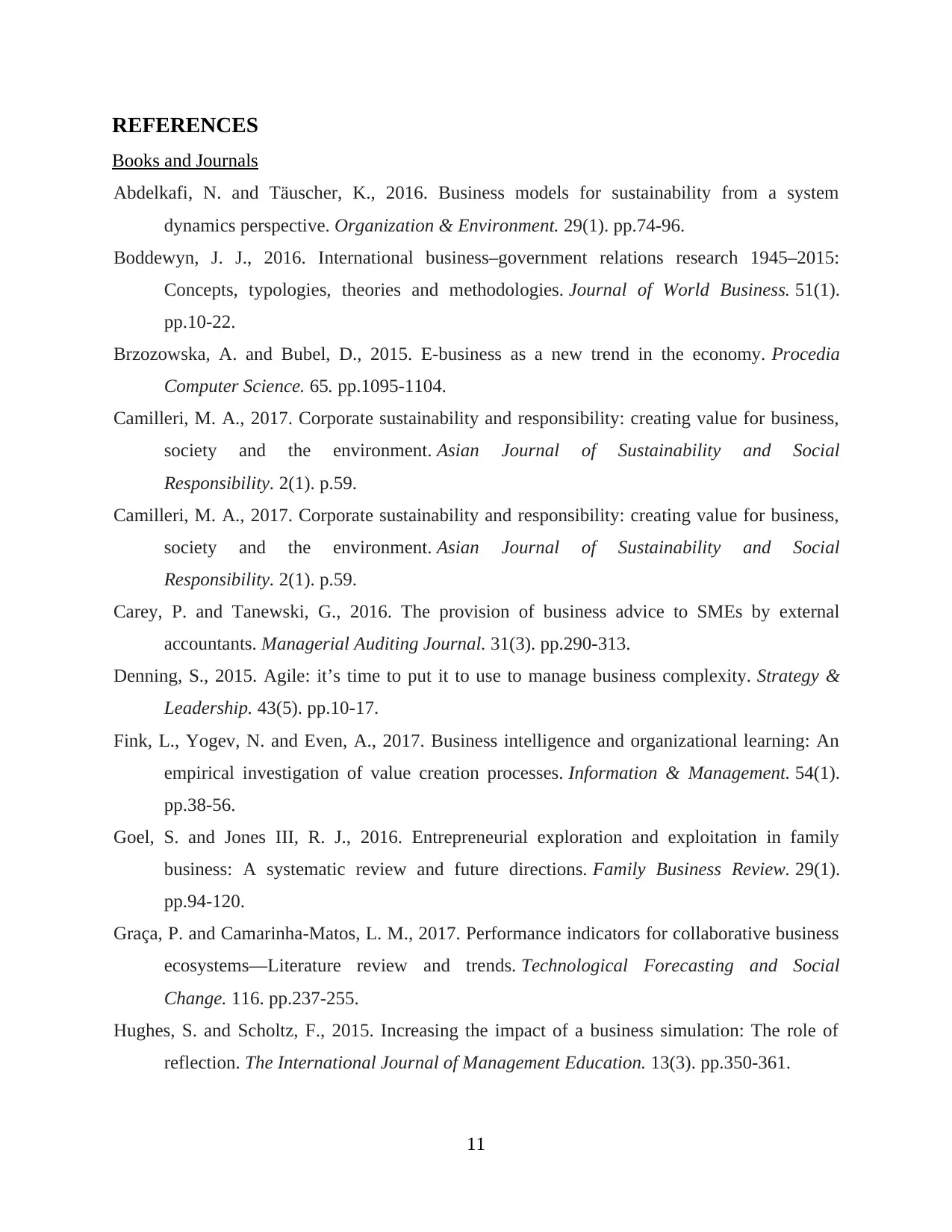
REFERENCES
Books and Journals
Abdelkafi, N. and Täuscher, K., 2016. Business models for sustainability from a system
dynamics perspective. Organization & Environment. 29(1). pp.74-96.
Boddewyn, J. J., 2016. International business–government relations research 1945–2015:
Concepts, typologies, theories and methodologies. Journal of World Business. 51(1).
pp.10-22.
Brzozowska, A. and Bubel, D., 2015. E-business as a new trend in the economy. Procedia
Computer Science. 65. pp.1095-1104.
Camilleri, M. A., 2017. Corporate sustainability and responsibility: creating value for business,
society and the environment. Asian Journal of Sustainability and Social
Responsibility. 2(1). p.59.
Camilleri, M. A., 2017. Corporate sustainability and responsibility: creating value for business,
society and the environment. Asian Journal of Sustainability and Social
Responsibility. 2(1). p.59.
Carey, P. and Tanewski, G., 2016. The provision of business advice to SMEs by external
accountants. Managerial Auditing Journal. 31(3). pp.290-313.
Denning, S., 2015. Agile: it’s time to put it to use to manage business complexity. Strategy &
Leadership. 43(5). pp.10-17.
Fink, L., Yogev, N. and Even, A., 2017. Business intelligence and organizational learning: An
empirical investigation of value creation processes. Information & Management. 54(1).
pp.38-56.
Goel, S. and Jones III, R. J., 2016. Entrepreneurial exploration and exploitation in family
business: A systematic review and future directions. Family Business Review. 29(1).
pp.94-120.
Graça, P. and Camarinha-Matos, L. M., 2017. Performance indicators for collaborative business
ecosystems—Literature review and trends. Technological Forecasting and Social
Change. 116. pp.237-255.
Hughes, S. and Scholtz, F., 2015. Increasing the impact of a business simulation: The role of
reflection. The International Journal of Management Education. 13(3). pp.350-361.
11
Books and Journals
Abdelkafi, N. and Täuscher, K., 2016. Business models for sustainability from a system
dynamics perspective. Organization & Environment. 29(1). pp.74-96.
Boddewyn, J. J., 2016. International business–government relations research 1945–2015:
Concepts, typologies, theories and methodologies. Journal of World Business. 51(1).
pp.10-22.
Brzozowska, A. and Bubel, D., 2015. E-business as a new trend in the economy. Procedia
Computer Science. 65. pp.1095-1104.
Camilleri, M. A., 2017. Corporate sustainability and responsibility: creating value for business,
society and the environment. Asian Journal of Sustainability and Social
Responsibility. 2(1). p.59.
Camilleri, M. A., 2017. Corporate sustainability and responsibility: creating value for business,
society and the environment. Asian Journal of Sustainability and Social
Responsibility. 2(1). p.59.
Carey, P. and Tanewski, G., 2016. The provision of business advice to SMEs by external
accountants. Managerial Auditing Journal. 31(3). pp.290-313.
Denning, S., 2015. Agile: it’s time to put it to use to manage business complexity. Strategy &
Leadership. 43(5). pp.10-17.
Fink, L., Yogev, N. and Even, A., 2017. Business intelligence and organizational learning: An
empirical investigation of value creation processes. Information & Management. 54(1).
pp.38-56.
Goel, S. and Jones III, R. J., 2016. Entrepreneurial exploration and exploitation in family
business: A systematic review and future directions. Family Business Review. 29(1).
pp.94-120.
Graça, P. and Camarinha-Matos, L. M., 2017. Performance indicators for collaborative business
ecosystems—Literature review and trends. Technological Forecasting and Social
Change. 116. pp.237-255.
Hughes, S. and Scholtz, F., 2015. Increasing the impact of a business simulation: The role of
reflection. The International Journal of Management Education. 13(3). pp.350-361.
11
Paraphrase This Document
Need a fresh take? Get an instant paraphrase of this document with our AI Paraphraser
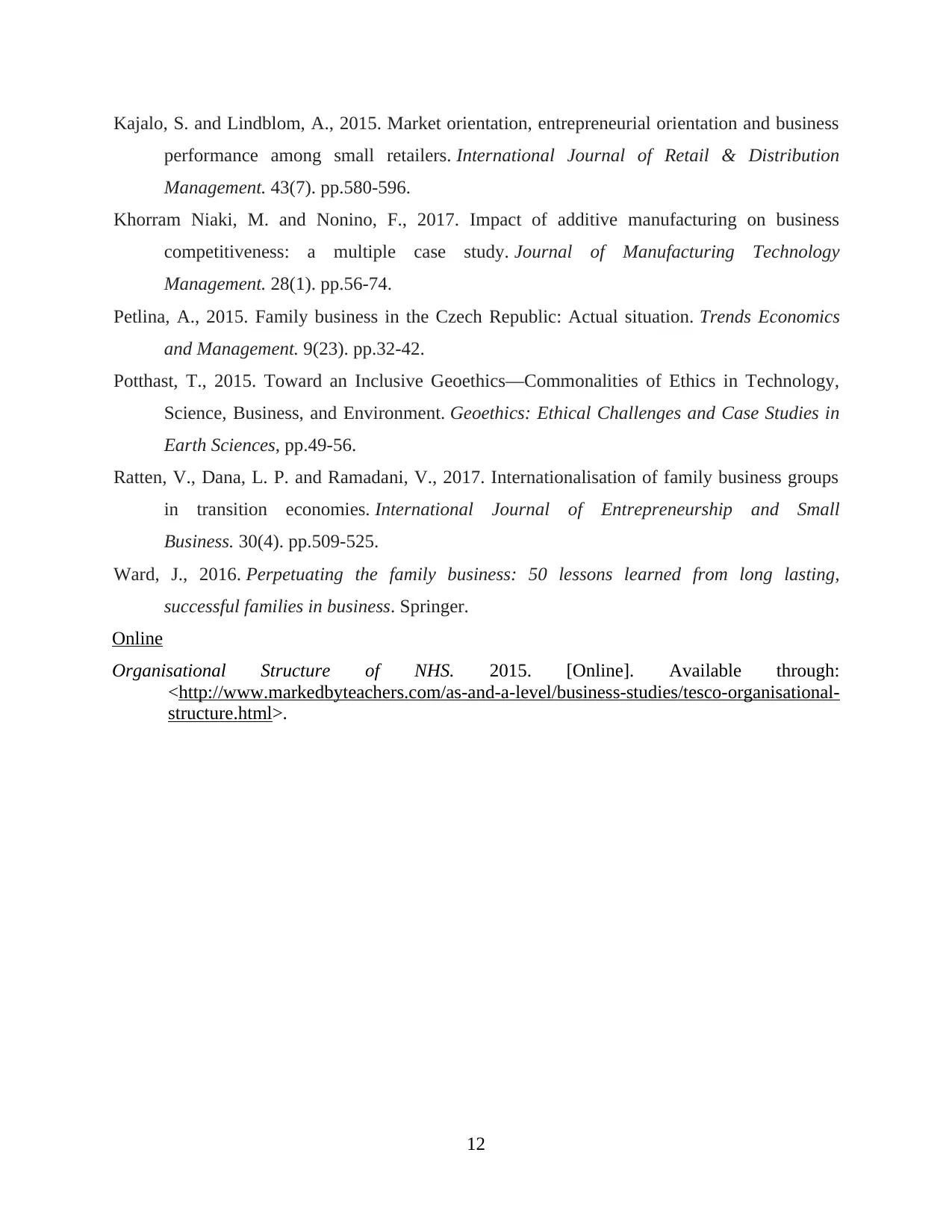
Kajalo, S. and Lindblom, A., 2015. Market orientation, entrepreneurial orientation and business
performance among small retailers. International Journal of Retail & Distribution
Management. 43(7). pp.580-596.
Khorram Niaki, M. and Nonino, F., 2017. Impact of additive manufacturing on business
competitiveness: a multiple case study. Journal of Manufacturing Technology
Management. 28(1). pp.56-74.
Petlina, A., 2015. Family business in the Czech Republic: Actual situation. Trends Economics
and Management. 9(23). pp.32-42.
Potthast, T., 2015. Toward an Inclusive Geoethics—Commonalities of Ethics in Technology,
Science, Business, and Environment. Geoethics: Ethical Challenges and Case Studies in
Earth Sciences, pp.49-56.
Ratten, V., Dana, L. P. and Ramadani, V., 2017. Internationalisation of family business groups
in transition economies. International Journal of Entrepreneurship and Small
Business. 30(4). pp.509-525.
Ward, J., 2016. Perpetuating the family business: 50 lessons learned from long lasting,
successful families in business. Springer.
Online
Organisational Structure of NHS. 2015. [Online]. Available through:
<http://www.markedbyteachers.com/as-and-a-level/business-studies/tesco-organisational-
structure.html>.
12
performance among small retailers. International Journal of Retail & Distribution
Management. 43(7). pp.580-596.
Khorram Niaki, M. and Nonino, F., 2017. Impact of additive manufacturing on business
competitiveness: a multiple case study. Journal of Manufacturing Technology
Management. 28(1). pp.56-74.
Petlina, A., 2015. Family business in the Czech Republic: Actual situation. Trends Economics
and Management. 9(23). pp.32-42.
Potthast, T., 2015. Toward an Inclusive Geoethics—Commonalities of Ethics in Technology,
Science, Business, and Environment. Geoethics: Ethical Challenges and Case Studies in
Earth Sciences, pp.49-56.
Ratten, V., Dana, L. P. and Ramadani, V., 2017. Internationalisation of family business groups
in transition economies. International Journal of Entrepreneurship and Small
Business. 30(4). pp.509-525.
Ward, J., 2016. Perpetuating the family business: 50 lessons learned from long lasting,
successful families in business. Springer.
Online
Organisational Structure of NHS. 2015. [Online]. Available through:
<http://www.markedbyteachers.com/as-and-a-level/business-studies/tesco-organisational-
structure.html>.
12
1 out of 14
Related Documents
Your All-in-One AI-Powered Toolkit for Academic Success.
+13062052269
info@desklib.com
Available 24*7 on WhatsApp / Email
![[object Object]](/_next/static/media/star-bottom.7253800d.svg)
Unlock your academic potential
© 2024 | Zucol Services PVT LTD | All rights reserved.





